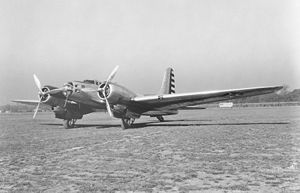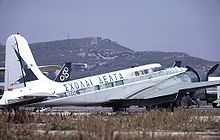- Douglas B-23 Dragon
-
B-23 Dragon A B-23 Dragon in USAAC markings during the early 1940s Role Medium bomber Manufacturer Douglas Aircraft Company First flight 27 July 1939 Primary user United States Army Air Corps Number built 38 Developed from B-18 Bolo The Douglas B-23 Dragon was a twin-engined bomber developed by Douglas Aircraft Company as a successor to (and a refinement of) the B-18 Bolo.
Contents
Design and development
Douglas proposed a number of modifications designed to improve the performance of the B-18. Initially considered a redesign, the XB-22 featured 1,600 hp Wright R-2600-1 Twin Cyclone radial engines. The complete B-18 redesign was considered promising enough by the USAAC to alter the original contract to produce the last 38 B-18As ordered under Contract AC9977 as the B-23.[1] The design incorporated a larger wingspan with a wing design very similar to that of the Douglas DC-3, a fully retractable undercarriage, and improved defensive armament. Notably, the B-23 was the first operational US bomber equipped with a glazed tail gun position.[1] The tail gun mounted a .50 caliber machine gun, which was fired from the prone position by a gunner using a telescopic sight. [2]
The first B-23 flew on July 27, 1939 with the production series of 38 B-23s manufactured between July 1939 and September 1940.
Operational history
While significantly faster and better armed than the B-18, the B-23 was not comparable to newer medium bombers like the North American B-25 Mitchell and Martin B-26 Marauder. For this reason, the 38 B-23s built were never used in combat overseas, although for a brief period, they were employed as patrol aircraft stationed on the west coast of the United States.[1] The B-23s were summarily relegated to other duties primarily training although 18 of the type were converted into transport versions as the UC-67.
Another role for the B-23 was to serve as a test-bed for new engines and systems. The B-23's tall vertical tail was adapted by Ford for use on the Consolidated B-24 Liberator and resulted in increased performance, but it was never adopted for production.[citation needed] The modification later became standard on the Navy's Consolidated PB4Y Privateer, which was derived from the Liberator.
After World War II, Howard Hughes converted a B-23 for use as his personal aircraft and other examples were used for executive transportation.
Operators
Survivors
On display
- B-23 Dragon, s/n 39-0036 is on display at the McChord Air Museum in McChord AFB, Washington.[3]
- B-23 Dragon, s/n 39-0045 is on display at the Castle Air Museum in Atwater, California.[4]
- B-23 Dragon, s/n 39-0051 is on display at the Pima Air & Space Museum in Tucson, Arizona.[5]
Under restoration
- B-23 Dragon, s/n 39-0033 is under restoration to airworthiness by Pissed Away N747M LLC in Bellevue, Washington.[6]
- B-23 Dragon, s/n 39-0037 is under restoration at the National Museum of the United States Air Force in Wright-Patterson AFB, Ohio.[7]
- B-23 Dragon, s/n 39-0038 is under restoration at the 1941 Historical Aircraft Group in Geneseo, New York.[8]
- B-23 Dragon, s/n 39-0046 is under restoration to airworthiness by E. M. Luke in Franklin, Louisiana.[9]
- B-23 Dragon, s/n 39-0057 is under restoration to airworthiness by Fantasy of Flight in Polk City, Florida.[10]
Mostly complete (Crash sites, famaged, etc.)
- B-23 Dragon, s/n "39-052" is a mostly complete crash site located at Loon Lake in the state of Idaho.[11]
Specifications (B-23 Dragon)
Data from Joe Baugher's Encyclopedia of American aircraft[12]
General characteristics
- Crew: 6
- Length: 58 ft 6 in (17.8 m)
- Wingspan: 92 ft (28 m)
- Height: 18 ft 6 in (5.6 m)
- Wing area: 993 ft² (92.3 m²)
- Empty weight: 19,089 lb (8,677 kg)
- Loaded weight: 26,500 lb (12,000 kg)
- Max takeoff weight: 32,400 lb (14,700 kg)
- Powerplant: 2 × Wright R-2600-3 radial engines, 1,600 hp (1,194 kW) each
Performance
- Maximum speed: 282 mph (245 kn, 454 km/h)
- Range: 1,400 mi (1,200 nmi, 2,300 km) with 4,000 lb (1,800 kg) of bombs
- Service ceiling: 31,600 ft (9,630 m)
- Rate of climb: 1,493 ft/min (7.6 m/s)
- Wing loading: 26.7 lb/ft² (130 kg/m²)
- Power/mass: 0.17 hp/lb (200 kW/kg)
Armament
- Guns:
- 3 × 0.30 in (7.62 mm) machine guns
- 1 × 0.50 in (12.7 mm) M2 Browning machine gun in tail turret
- Bombs: 4,000 lb (1,814 kg)
See also
- Related development
- Aircraft of comparable role, configuration and era
References
- Notes
- ^ a b c Mondey 1982, p. 111.
- ^ "Stinger Gun in Plane's Tail Guards Vulnerable Spot." Popular Science, January 1941.
- ^ "B-23 Dragon/sn 39-0036." USAF Museum. Retrieved: 31 May 2011.
- ^ "B-23 Dragon/sn 39-0045." USAF Museum. Retrieved: 31 May 2011.
- ^ "B-23 Dragon/sn 39-0051." USAF Museum. Retrieved: 31 May 2011.
- ^ "B-23 Dragon/sn 39-0033." FAA Registry. Retrieved: 31 May 2011.
- ^ "B-23 Dragon/sn 39-0037." USAF Museum. Retrieved: 31 May 2011.
- ^ "B-23 Dragon/sn 39-0038." 1941 Historical Aircraft Group. Retrieved: 25 December 2010.
- ^ "B-23 Dragon/sn 39-0046." FAA Registry. Retrieved: 31 May 2011.
- ^ "B-23 Dragon/sn 39-0057." FAA Registry. Retrieved: 31 May 2011.
- ^ "B-23 s/n 39-052 Today." AviationArcheology.com. Retrieved: 2 September 2011.
- ^ Baugher, Joe. "B-23 'Dragon'." Joe Baugher's Encyclopedia of American aircraft, 23 November 2000. Retrieved: 12 June 2010.
- Bibliography
- Mondey, David. The Hamlyn Concise Guide to American Aircraft of World War II. London: Hamlyn Publishing Group Ltd., 2002, (republished 1996 by the Chancellor Press), First edition 1982. ISBN 1-85152-706-0.
External links
Douglas military aircraft Fighters Ground attack Naval bombers
and attack aircraftBombers Observation Patrol PD · P2D · P3D
Reconnaisance Transports C-1 · C-21 · C-32 · C-33 · YC-34 · C-38 · C-39 · C-41 · C-41A · C-42 · C-47 · C-48 · C-49 · C-50 · C-51 · C-52 · C-53 · C-54 · C-58 · UC-67 · C-68 · C-74 · C-84 · C-110 · XC-112/YC-112 · XC-114 · YC-116 · C-117 · C-118 · C-124 · YC-129 · C-133 · XCG-17
C-9 · C-24
RD · R2D · R3D · R4D (R4D-2 & R4D-4) · R5D · JD · R6D
CC-129 · Dakota I/III/IV · Dakota II · LXD1 · PD.808 · Skymaster ITraining aircraft Experimental USAAS/USAAC/USAAF/USAF bomber designations 1924–1962 Bomber XB-1 · B-2 · B-3 · B-4 · B-5 · B-6 · Y1B-7 · XB-8 · YB-9 · B-10 · YB-11 · B-12 · XB-13 · XB-14 · XB-15 · XB-16 · B-17 · B-18 · XB-19 · Y1B-20 · XB-21 · XB-22 · B-23 · B-24 · B-25 · B-26 · XB-27 · XB-28 · B-29 · XB-30 · XB-31 · B-32 · XB-33 · B-34 · YB-35 · B-36 · B-37 · XB-38 · XB-39 · YB-40 · XB-41 · XB-42 · XB-43 · XB-44 · B-45 · XB-46 · B-47 · XB-48 · YB-49 · B-50 · XB-51 · B-52 · XB-53 · B-54 · XB-55 · XB-56 · B-57 · B-58 · XB-59 · YB-60 · B-61 · B-62 · B-63 · B-64 · B-65 · B-66 · B-67 · XB-68/SM-68 · RB-69 · XB-70 · SR-71
Light bomber Heavy bomber XHB-1 · XHB-2 · XHB-3
Long-range bomber USAAS/USAAC/USAAF/USAF transport designations 1925–1962, 2005-2006 Main sequence
1925-1962C-1 • C-2 • C-3 • C-4 • C-5 • C-6 • C-7 • C-8 • C-9 • XC-10 • Y1C-11 • Y1C-12 • C-13 (Not assigned) • C-14 • C-15 • C-16 • Y1C-17 • C-18 • C-19 • C-20 • C-21 • Y1C-22 • Y1C-23 • Y1C-24 • Y1C-25 • C-26 • C-27 • C-28 • C-29 • YC-30 • C-31 • C-32 • C-33 • C-34 • XC-35 • C-36 • C-37 • C-38 • C-39 • C-40 • C-41/A • C-42 • UC-43 • C-44 • C-45 • C-46 • C-47 • C-48 • C-49 • C-50 • C-51 • C-52 • C-53 • C-54 • C-55 • C-56 • C-57 • C-58 • C-59 • C-60 • UC-61 • C-62 • C-63 • C-64 • C-65 • C-66 • UC-67 • C-68 • C-69 • UC-70/A/B/C/D • UC-71 • UC-72 • C-73 • C-74 • C-75 • C-76 • UC-77 • C-78 • C-79 • C-80 • UC-81 • C-82 • C-83 • C-84 • UC-85 • C-86 • C-87 • C-88 • C-89 • C-90 • C-91 • UC-92 • C-93 • UC-94 • UC-95 • UC-96 • KC-/C-97 • C-98 • XC-99 • UC-100 • UC-101 • C-102 • UC-103 • C-104 • C-105 • C-106 • C-107 • C-108 • C-109 • C-110 • C-111 • XC-112 • XC-113 • XC-114 • XC-115 • XC-116 • C-117 • C-118 • C-119 • XC-120 • C-121/F • YC-122 • C-123/A • C-124 • YC-125 • LC-126 • C-127 (I) • C-127 (II) • C-128 • YC-129 • C-130 • C-131 • C-132 • C-133 • YC-134 • KC-/C-135 • C-136 • C-137 • C-138 (Not assigned) • C-139 (Not assigned) • C-140 • C-141 • XC-142
Revived sequence
2005-2006C-143 • C-144
See also: Post-1962 listLists relating to aviation General Aircraft (manufacturers) · Aircraft engines (manufacturers) · Airlines (defunct) · Airports · Civil authorities · Museums · Registration prefixes · Rotorcraft (manufacturers) · TimelineMilitary Accidents/incidents Records Categories:- Douglas aircraft
- United States bomber aircraft 1930–1939
Wikimedia Foundation. 2010.


